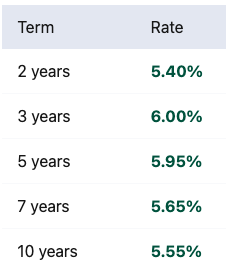Annuity Fees
In addition to the premium you pay into an annuity, there are numerous other fees you may owe as well. Which fees may apply to your annuity contract depends on the type of annuity you purchase; some types of annuities, like immediate annuities, have very few additional costs, while some charges, like surrender fees, only come into play if you attempt to withdraw money from your annuity early.
Potential Annuity Fees
- Commissions
- Administrative fees
- Mortality expenses
- Surrender charges
- Rate spreads
- Investment expense ratio
- Riders
A better understanding of the different types of fees connected to annuities can help you select the right type of financial product for your situation.
How soon are you retiring?
What is your goal for purchasing an annuity?
Select all that apply
Commissions vs. Fees
When you purchase an annuity, you typically work with an agent who helps the issuing company sell you the contract. As with other types of agents, yours will likely receive a commission. The commission is usually built into the price of the contract.
“Commissions are different from fees. There are a lot of really complex types of annuities where a salesperson’s paid a really high commission,” Rob Williams, managing director at the Schwab Center for Financial Research, told Annuity.org. “The person who’s buying them won’t see that. They’re not charged for it.”
Commissions can vary depending on the total value of your contract and the annuity type. Typically, the more complex the annuity, the higher the commission.
The commission on a 10-year fixed index annuity ranges from 6% to 8%. Commissions on single premium immediate annuities typically range from 1% to 3%.
Typical Commissions By Annuity Type
- Single Premium Immediate Annuity: 1% to 3%
- Multi-Year Guaranteed Annuity (MYGA): 1% to 3%
- Deferred Income Annuity: 2% to 4%
- Fixed Index Annuity: 6% to 8%
“It’s worth asking any time you’re working with someone – whether it’s a firm like Schwab who offers access to annuities, or an individual annuity company or a person – ask ‘how are you being paid? Are you being paid a commission?’” Williams said.
What Commissions Could Look Like For You
Imagine you purchase an annuity where your total premium is $100,000. You add features to customize the annuity to your liking, making it a reasonably complex product.
The agent you worked with would likely receive a commission in the 5% range, netting them about $5,000.
Remember: The commission is usually built into the cost of the annuity contract. Assuming this is the case, you would not be charged an additional $5,000 when you sign the contract.
Commissions can be substantial from annuity sales, but that should not be the determining factor on why you would buy or not buy an annuity. A good reason to ask what an advisor is getting paid for an annuity they are selling you is to be able to have full disclosure given. Many agents will sell annuities that are paying higher commissions to themselves, but also providing lower guarantees to you as the consumer. You should be aware of this possible conflict of interest and ask to see ALL annuities available.
Administrative Fees and Mortality Expenses
Administrative fees are exactly what they sound like: Fees you pay for someone to manage your annuity. This fee is generally about 0.3% of the value of your annuity contract.
While this sounds reasonable, it is likely a higher fee than you would pay on a 401(k) or IRA.
Your administrative fee could be a flat payment versus a percentage of your contract.
Mortality expenses compensate the insurance company for the risk it takes by agreeing to a contract with you. The company may charge the fee as a commission. It can range from 0.5% to 1.5% of the policy value each year.
What Administrative and Mortality Fees Could Look Like For You
Let’s return to our original example, where you purchase an annuity with $100,000. Your administrative fee of 0.3% would cost you $300.
The mortality expenses would be heftier. If your provider were to charge you 1% for mortality costs — which is right in the middle of the general range — then you would pay an additional $1,000.
You could expect to pay $1,300 in administrative and mortality fees in this example.
Surrender Charges
Surrender charges may be the steepest fees you can face with an annuity. But you only pay this fee if you take money from your annuity before the contract allows.
Michael M., who requested his last name be kept private, purchased an annuity for himself after he retired from a career as an annuity and life insurance salesman. He opted for a multi-year guaranteed annuity, or MYGA.
The prospect of a high surrender fee wasn’t something that bothered him because he knew the odds of him having to take money out of his annuity contract were low.
“That wasn’t really a concern because I pre-planned very well,” he told Annuity.org.
The surrender charge itself varies significantly from contract to contract. It may start at around 10% of the contract’s total value and, according to the Insurance Information Institute, usually decreases slightly each year until the surrender period has passed.
Surrender periods on annuity contracts often last six to eight years.
In addition to a surrender fee, you could face a withdrawal fee from the IRS if you attempt to take money from your annuity before you are 59 ½.
What Surrender Charges Could Look Like For You
In our example, let’s say that when you purchased your $100,000 annuity, you agreed to a six-year surrender period. Your potential surrender fee started high and has decreased by a percent each year.
Due to changing life circumstances, you decide to withdraw money from the annuity after two years. You withdraw $20,000 and pay a 5% fee, equivalent to $1,000 on that withdrawal.
Remember: The fee applies to the entire annuity withdrawal amount. For example, if you withdraw $50,000 instead of $20,000, your fee would rise from $1,000 to $2,500.

Calculate Your Returns Based on Today’s Best Rates
Fees by Annuity Type
The exact fees you are responsible for when you buy an annuity will depend heavily on the type of product you purchase.
Particular fees, such as rate spreads or investment expense ratios, only apply to certain annuities.
Annuity Fees by Type
| Fees | Variable Annuity | Fixed Index Annuity | Fixed Annuity | Immediate Annuity |
|---|---|---|---|---|
| Commissions | ✓ | ✓ | ✓ | ✓ |
| Administrative Fees | ✓ | ✓ | ✓ | ✓ |
| Surrender Charges | ✓ | ✓ | ✓ | |
| Mortality Expenses | ✓ | ✓ | ||
| Investment Expense Ratio | ✓ | ✓ | ||
| Riders | ✓ | ✓ | ✓ | ✓ |
| Rate Spreads | ✓ | ✓ |
A good rule of thumb when comparing annuities by fee is that the more complex your annuity is, the more potential fees you may face. Expect to owe more if you add multiple riders and customizations to your contract.
“I am often asked, ‘What is the average cost or fee associated with an annuity?’ And it really can depend on different factors, but more than anything, the type of annuity that you’re looking at,” Christopher Magnussen, a licensed agent, told Annuity.org.
“So if you’re looking at a fixed annuity, similar to a CD, referred to as a MYGA, those have no fees. Those have no cost involved,” Magnussen said. “Same exact thing is seen with an immediate annuity — that is really more an educated guess on the part of the insurance company by looking at mortality tables and your gender, what your expected lifetime is going to be.”
Annuities with the Highest Fees
Variable and fixed index annuities tend to be more complex, and while they include the typical charges – administrative fees, mortality expenses, commissions, etc. – that you’ll find with most annuities, they have several additional fees as well.
Annuities With Higher Fees
One additional fee to consider is the rate spread. Dave Bochichio, a certified educator in personal finance and founder of Clean Cut Finance, told Annuity.org, “A spread is a percentage of gains that the insurance company takes each year before distributing interest into the annuity’s account.”
Simply put, the issuing company of your fixed index or variable annuity will subtract a percentage of the interest rate earned by your product.
A spread is only subtracted if the annuity earns interest and isn’t something you need to worry about if no interest is accrued due to poor market performance.
Variable and fixed index annuities are also subject to an investment expense ratio, a fee for managing the annuity’s investments. It can range from 0.6% to over 3% each year.
Annuities with the Lowest Fees
The more straightforward and simplified your contract, the fewer fees you may owe. A great example is an immediate annuity, which typically involves converting a lump-sum premium into a stream of guaranteed payments.
“The general assumption, which is sort of stated as a fact, is that annuities are very expensive,” Williams said. “Well, immediate annuities have no explicit fee. There’s no fee. The profit that the annuity provider makes off of them is embedded in the quotes that they give you on the payouts.”
Annuities With Lower Fees
- Fixed annuities
- Immediate annuities
The commission is also likely a lower percentage of your contract if you purchase a more basic or simple type of annuity.
Secure Retirement Without Hidden Fees
Are Annuities Worth the Fees?
Whether an annuity is worth the fees will depend entirely on your situation.
Different people have different appetites for fees. You may be comfortable exchanging higher costs than you would see on other financial products for the peace of mind that comes from assured income for the rest of your life.
Some buyers may also choose to focus on the types of annuities that include the fewest fees.
“I figured out what I wanted was something basically very simple, and didn’t have a lot of extra charges to it,” Annuity.org customer Tracy Neill said.
Williams told Annuity.org that a critical question for people to ask themselves is what they want to accomplish.
Getting to the heart of what you hope to achieve can determine if an annuity makes sense.
“Variable annuities — if you just have no real bells and whistles — they’re a little bit like a vehicle to have tax-deferred investments … you can do that with an IRA potentially, and many IRAs have no fees,” he said. “Now, if they maxed out their IRA and they’re like, ‘well, I want other places to invest,’ then you might go to the variable annuity.”
Fully understanding your financial picture can help you determine whether the fees associated with an annuity are worth it.






